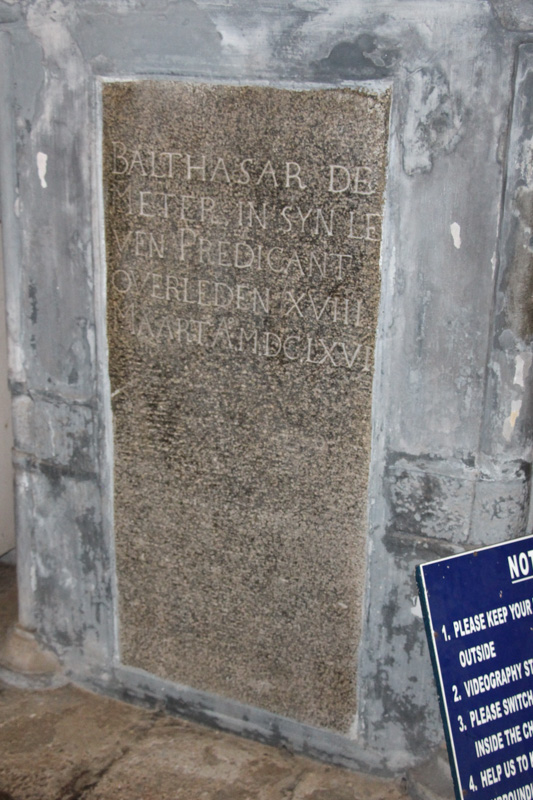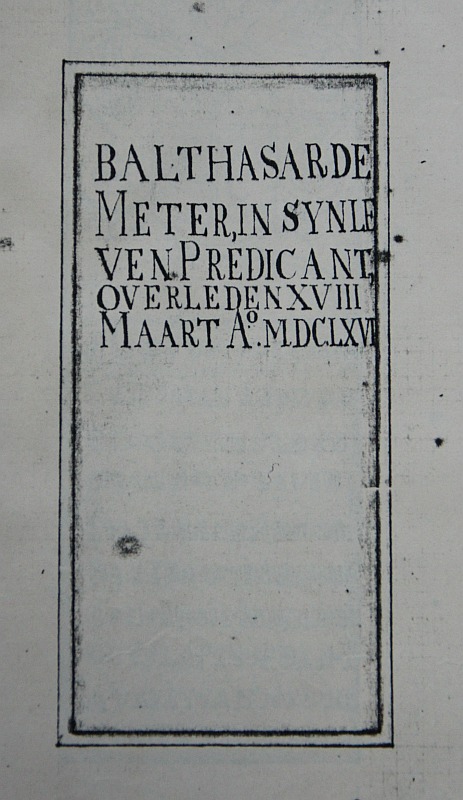Fort Kochi - Balthasar de Meter
On 11 August 1646, the Heren XVII took the decision to do something about the shortage of clergymen in Asia with the coming outgoing fleet. Six ministers, not Germans, but only educated men, would be sent out. The chambers Amsterdam and Zeeland would each take care of 2 ministers and the Zuider- and Noorderkwartier each for one minister.[i]
Six ministers on a fleet of 2,900 men. During the preparations for the new fleet, no decision was made with regard to the clergymen. From that moment on there had to be at least 28 ministers in the East Indies. On Batavia three, two in Malacca, seven on Formosa (Taiwan), three in the Moluccas, five on Ambonia (Ambon), five on Banda, two on Ceylon and one in Paliacatte (Pulicat).[ii] Because at that time there were only seventeen ministers in the whole of the Indies, eight had to be sent with the coming fleet. After some time, there were seven, so Amsterdam had to take care of three ministers. But that is not all. Ministers found it difficult to entice themselves to go to the Indies, so working conditions had to be improved. Ministers were allowed to take their wife with them to make the stay more attractive, but when a minister died, his widow was empty-handed and wanted to return to the Netherlands. This led to costs for the VOC and that is why it was decided that in the future, when widows would stay in the Indies, they would receive 100 guilders a year and a half-monthly ration. It was also needed to improve housing and there should be more money for the ministers to help the needy. Moreover, in Batavia one had to ensure that everyone who made a will also made a bequest to the poor.
The details of the application of Balthasar Obiae de Meter we will never know. The minutes of the meetings for the Christmas and spring fleet 1646/1647 are missing from both the books of Amsterdam and those of Zeeland. But the outcome was positive. Balthasar was probably Frisian by birth. He attended the gymnasium of Leeuwarden and in the period from 21 March 1635 to 1638 the University of Franeker. [iii] He had been known as a minister since 1641 and in 1642 had received a permanent appointment in Hollum on Ameland. From there he left in the spring of 1647 with his wife Dieucke Hessels to Batavia to travel to Malacca. Tombstone of Balthasar de Meter (photo René ten Dam, 2020)
Tombstone of Balthasar de Meter (photo René ten Dam, 2020)
This city, on the peninsula of Malaysia, was conquered by the Dutch from the Portuguese in 1641. Balthasar was the fourth Dutch minister in the city and had Guilielmus Pantherus as a colleague for the first year, but disputes soon arose, so the latter left in 1648. Balthasar learned to speak Portuguese well here and, together with a Portuguese, had translated the Heidelberg catechism and liturgy into Portuguese. In 1650 he asked the Chamber of Amsterdam to publish it in print and to send these books to Malacca. It must have been a bitter pill for him when this was refused because he had not consulted with the Governor General in advance. In 1651 a new fellow minister appeared on the scene. Gualtherus Bakker would only stay for a brief time and was recalled - again because of differences that had arisen. Balthasar had already finished his four-year employment, when he was replaced in 1655 and the couple repatriated. He stayed at the Cape of Good Hope for some time. On 15 March 1657, the ship the Walvis arrived at the Cape of Good Hope with which De Meter and his wife would sail back to Holland.[iv]
Balthasar returned to Friesland and settled in Franeker. He enrolled there as a member on 18 October 1657, arriving from Malacca. His wife's family also lived in this area. [v] In 1657 he became a minister at Winsum, Baard en Huins at Franeker and was a member of the Frisian Synod in 1660. However, India continued to attract. At the end of 1662 Balthasar informed the church council that he wanted to return to Asia. He was given, together with his wife, a place on a ship from the spring fleet of 1663.
On 6 April 1663 the ship Durgerdam arrived at the Cape of Good Hope. There the daughter Virena of the admiral Herman Klincke was born on board and baptized by Balthasar, as she was entered in the baptismal book. On 8 April he made a sermon at the Cape of Good Hope and baptized four more children. Also on 15 April he led a church service, to board again that same day on his way to Batavia.[vi]
De Meter had asked to be sent to a place where his knowledge of Portuguese would benefit him. That became Ceylon and from there he was sent to the city of Cochin on the Malabar coast, which was conquered from the Portuguese in 1663. This effectively put him in the same situation as in Malacca, where a whole new community had to be built. At the time of the transfer of Cochin from the Portuguese to the Dutch, a number of requirements were drawn up with regard to the inhabitants. Unmarried Portuguese were immediately sent back to Portugal. Portuguese, when married to a mestizo woman, were allowed to move to Goa taking a bed, some household goods and a hump bag. Toepas[vii], Canarins and Christians were allowed to stay provided they were not catholic. What to do with the larger group of St. Thomas Christians[viii], they did not yet know exactly. They were recognized as Christians, but their faith differed so much from Protestantism that they did not yet know whether they should be treated in the sense of Christians. This question was essential because it was felt that all Christians were under the legal authority of the VOC. Eventually, the outflow of people was so great that there was no craftsman left and the (re)construction of houses and the fortress stagnated. The VOC saw no other way than to ease up the rules so that Portuguese who were married to a mestizo woman were welcome again. Unfortunately for Balthasar de Meter, this did not help in the construction of the small congregation of Christians because Portuguese people had a Catholic background. Despite the fact that the regulations of the VOC stated that they only hired people who were Protestant, the reality was different if only because the many foreigners who were employed often had a different religious belief. The authorities in Ceylon felt that De Meter was not doing enough and he was refused a salary increase. The question is whether Balthasar de Meter has received this message. He died on 18 March 1666 in Cochin and was buried in St. Francis Church.
The oldest Dutch tombstones are quite rudimentary, with only text and without decorations. It confirms that in the early days there were few craftsmen left. This can be clearly seen on the dark reddish-brown tombstone of Balthasar de Meter. The stone bears only the text: BALTHASAR DE METER, IN SYN LIFE PREDICANT DIED XVIII MARCH Ao MDCLXVI. In translation: Balthasar de Meter, in his life minister. Died 18 March 1666.
 Drawing of the tombstone
Drawing of the tombstone
In 1937 the naval ship Hr. Ms. de Ruyter visited Bombay. On the occasion of this visit, an article was written about the Dutch past of Cochin among others in the newspaper: "a number of tombstones from the area have been brought together in the church of St. Francis in Cochin and placed in a row against the church wall, Balthasar de Meter, Isaac van Dielen, Cornelis de la Haye and the housewife of Jacob de Jong and many others, fraternally next to the Perera's, Da Costa's and other Portuguese. Thus, ironic fate unites friend and foe after death in this kindly forgotten church."[ix]
Notes
[i] NA 1.04.02.102_0107
[ii] NA 1.04.02.102_0149
[iii] Album Studiosorum 1598-1638 Samme Zijlstra: Het geleerde Friesland, students ca. 1380 - 1650
[iv] Die wordingsgeskiedenis van die Hollandse Kerke in Suid-Afrika 1652-1804 blz 193 H.D. van Broekhuizen
[v] Harco Hessels, notary publicus in Bergum was Balthasar's brother-in-law.
[vi] Bouwstoffen voor de geschiedenis der Nederduitsche-Gereformeerde kerken in Zuid-Afrika blz 25-26
[vii] Free Christian-native on Malabar, Coromandel and Ceylon, mostly freed slaves.
[viii] The Thomas Christians trace their origin to St Thomas, the Apostle of Jesus. Most scholars agree that before the Portuguese era (pre-16th century), St Thomas Christians were under the spiritual jurisdiction of the Church of East (differently known as the Church of Babylon, Chaldea, Persia etc.), who followed East Syriac Rite and had bishops sent by the Patriarch or the Head of this church.
[ix] Indische Courant 11-2-1937. [Ed. The journalist is misinformed. There are no sources the Dutch slabs are from outside the church, nor are the Portuguese.]
- Last updated on .


